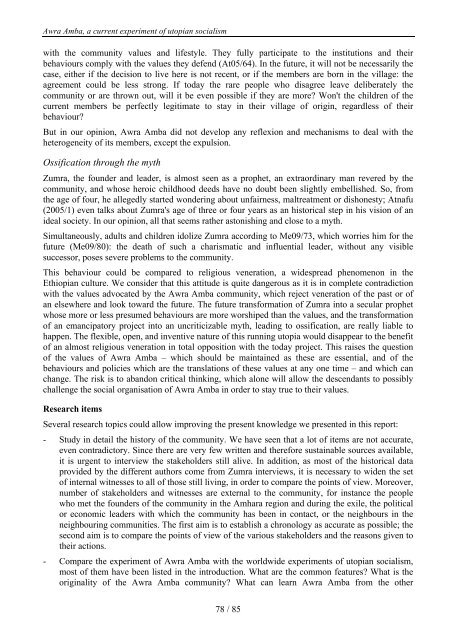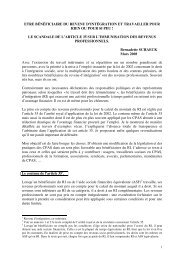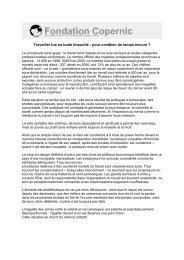Awra Amba RJ 300612 EN - Contacter un comité local d'Attac
Awra Amba RJ 300612 EN - Contacter un comité local d'Attac
Awra Amba RJ 300612 EN - Contacter un comité local d'Attac
Create successful ePaper yourself
Turn your PDF publications into a flip-book with our unique Google optimized e-Paper software.
<strong>Awra</strong> <strong>Amba</strong>, a current experiment of utopian socialism<br />
with the comm<strong>un</strong>ity values and lifestyle. They fully participate to the institutions and their<br />
behaviours comply with the values they defend (At05/64). In the future, it will not be necessarily the<br />
case, either if the decision to live here is not recent, or if the members are born in the village: the<br />
agreement could be less strong. If today the rare people who disagree leave deliberately the<br />
comm<strong>un</strong>ity or are thrown out, will it be even possible if they are more? Won't the children of the<br />
current members be perfectly legitimate to stay in their village of origin, regardless of their<br />
behaviour?<br />
But in our opinion, <strong>Awra</strong> <strong>Amba</strong> did not develop any reflexion and mechanisms to deal with the<br />
heterogeneity of its members, except the expulsion.<br />
Ossification through the myth<br />
Zumra, the fo<strong>un</strong>der and leader, is almost seen as a prophet, an extraordinary man revered by the<br />
comm<strong>un</strong>ity, and whose heroic childhood deeds have no doubt been slightly embellished. So, from<br />
the age of four, he allegedly started wondering about <strong>un</strong>fairness, maltreatment or dishonesty; Atnafu<br />
(2005/1) even talks about Zumra's age of three or four years as an historical step in his vision of an<br />
ideal society. In our opinion, all that seems rather astonishing and close to a myth.<br />
Simultaneously, adults and children idolize Zumra according to Me09/73, which worries him for the<br />
future (Me09/80): the death of such a charismatic and influential leader, without any visible<br />
successor, poses severe problems to the comm<strong>un</strong>ity.<br />
This behaviour could be compared to religious veneration, a widespread phenomenon in the<br />
Ethiopian culture. We consider that this attitude is quite dangerous as it is in complete contradiction<br />
with the values advocated by the <strong>Awra</strong> <strong>Amba</strong> comm<strong>un</strong>ity, which reject veneration of the past or of<br />
an elsewhere and look toward the future. The future transformation of Zumra into a secular prophet<br />
whose more or less presumed behaviours are more worshiped than the values, and the transformation<br />
of an emancipatory project into an <strong>un</strong>criticizable myth, leading to ossification, are really liable to<br />
happen. The flexible, open, and inventive nature of this r<strong>un</strong>ning utopia would disappear to the benefit<br />
of an almost religious veneration in total opposition with the today project. This raises the question<br />
of the values of <strong>Awra</strong> <strong>Amba</strong> – which should be maintained as these are essential, and of the<br />
behaviours and policies which are the translations of these values at any one time – and which can<br />
change. The risk is to abandon critical thinking, which alone will allow the descendants to possibly<br />
challenge the social organisation of <strong>Awra</strong> <strong>Amba</strong> in order to stay true to their values.<br />
Research items<br />
Several research topics could allow improving the present knowledge we presented in this report:<br />
- Study in detail the history of the comm<strong>un</strong>ity. We have seen that a lot of items are not accurate,<br />
even contradictory. Since there are very few written and therefore sustainable sources available,<br />
it is urgent to interview the stakeholders still alive. In addition, as most of the historical data<br />
provided by the different authors come from Zumra interviews, it is necessary to widen the set<br />
of internal witnesses to all of those still living, in order to compare the points of view. Moreover,<br />
number of stakeholders and witnesses are external to the comm<strong>un</strong>ity, for instance the people<br />
who met the fo<strong>un</strong>ders of the comm<strong>un</strong>ity in the Amhara region and during the exile, the political<br />
or economic leaders with which the comm<strong>un</strong>ity has been in contact, or the neighbours in the<br />
neighbouring comm<strong>un</strong>ities. The first aim is to establish a chronology as accurate as possible; the<br />
second aim is to compare the points of view of the various stakeholders and the reasons given to<br />
their actions.<br />
- Compare the experiment of <strong>Awra</strong> <strong>Amba</strong> with the worldwide experiments of utopian socialism,<br />
most of them have been listed in the introduction. What are the common features? What is the<br />
originality of the <strong>Awra</strong> <strong>Amba</strong> comm<strong>un</strong>ity? What can learn <strong>Awra</strong> <strong>Amba</strong> from the other<br />
78 / 85

















